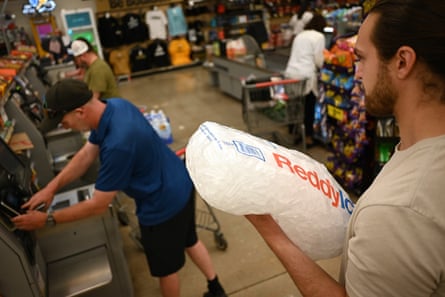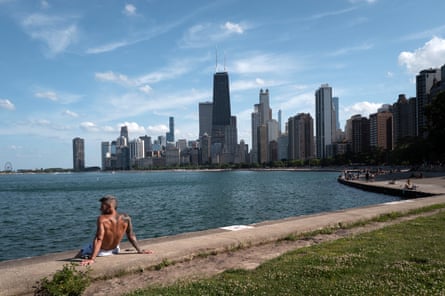At a splash pad on the banks of the Great Miami River in downtown Dayton, Michelle Winston, her partner and their daughter have come to cool off from the brutal heat.
“It’s our first time down here this year, but because it’s so hot, we’ll be coming back for sure,” she says as she helps her daughter clear water from her eyes.
Winston, her family and around 25 other Daytonians at the splash pad are among the millions of midwesterners seeking relief from a severe heat dome that’s engulfed the eastern US this week.
In Kentucky, Louisville’s metro emergency services initiated Operation White Flag on Monday, which allows people to access two of its shelters when the heat index crosses 95F (35C) – nine degrees above normal for this time of year.
Cities across Ohio broke their daily high temperatures on Sunday for that date.
Inevitably, the soaring temperatures have drawn people such as Winston to water, which has its own risks. A spate of drownings at lakes, quarries and rivers have been reported in recent days. The Chicago fire department responded to 90 calls related to heat and water emergencies over the weekend. Authorities are pleading with people to take care around waterways.
Heat kills more people in the US than hurricanes, tornadoes and floods combined.

Worsening the situation are ever-expanding suburbs of concrete buildings and asphalt roads, which serve as heat reservoirs, sucking in the sun’s heat during the day, before releasing it at night. That results in higher overnight temperatures which, in turn, fuel greater demand from artificial cooling systems. Across the region, those systems are often powered by electricity that’s generated by climate warming fossil fuels such as natural gas.
While extreme weather has always been a feature of life in the midwest, experts say warming global temperatures are contributing to more severe, less stable weather patterns.
A 2023 study found the midwest would likely suffer more than most other regions around the world from being a “moist heat stress hotspot” if global temperatures increase above a 3C threshold from current levels. Studies show that heat-related deaths have increased dramatically in recent years, in line with rising global temperatures.
Nor have rural communities managed to escape the heat.
While trees and natural vegetation can play an important role in soaking up the sun’s radiant heat, “corn sweat”, in which the hugely popular crop releases moisture from its leaves into the atmosphere, is a real contributor to humidity in rural areas.
“I’ve grown up with that; it’s just part of farming,” says Bill Wiley, who grows wheat, corn, soybeans and specialty vegetables on 500 acres in Ohio’s Shelby county. This week, he’s been doing most of his farm work in the evening time to avoid the heat.
What Wiley, however, is more concerned with is the bigger climate picture.
“Climate change shouldn’t be, but is, a political controversy among farmers. On the other hand, when you talk to farmers anecdotally, they say that the weather is much less predictable than it used to be,” he says.

Wiley says rainstorms in March resulted in severe localized flooding and road closures that neither he nor others had witnessed in the past. “The drought we had last year was more extreme than we’ve had in 20-something years. Things are happening that push the limits of what many would consider to be normal,” he says.
Despite much of the state being covered with lush forest, West Virginia is in the midst of record temperatures and an extreme heat warning this week, the likes of which has not been experienced since the 1930s.
For Thomas Rodd, a climate activist based in Moatsville, West Virginia, the state’s verdant topography hides a more sinister reality.
“Right now, across West Virginia, western Pennsylvania and Ohio, there are literally thousands of old gas wells that are leaking methane gas, which is a major greenhouse gas. We need to increase funding for projects so that they don’t continue to release methane into the atmosphere,” he says.
“There’s really almost a 100% agreement among scientists that we are facing record-high temperatures in the future. It’s really a terrifying prospect. Unfortunately, West Virginia has contributed to that. People have burned a lot of coal and gas here.”
In addition to the heat, Rodd says there are other climate crisis-related extremes playing out in West Virginia.
“Climate change is not just driving high temperatures; it’s leading to more extreme flooding. It’s shifting everything.”
At least eight people died in flash flooding in the West Virginia panhandle this month, when up to four inches of rain fell in just 30 minutes. The flooding caused power outages for thousands and gas leaks.
“We need to leave the old growth trees where they are. We have huge numbers of these trees in West Virginia and unfortunately the Trump administration wants to take them away,” he says. On Monday, the US agriculture secretary, Brooke Rollins, announced that 59m acres of national forests around the US would be opened up to logging. West Virginia is home to two national forests comprising more than a million acres. More than 78% of the state is forested, the third-highest percentage in the US after Maine and New Hampshire.
In times of extreme weather such as this, farmers and farm workers are highly dependent on accurate weather forecasting, and the Trump administration’s gutting of the National Oceanic and Atmospheric Administration could make it harder for farmers, ranchers and their staff to safely and efficiently do the work that puts food on the tables of hundreds of millions of Americans.
“Farmers do a lot based on their decisions around whether it’s going to rain or be dry,” says Wiley. “[The cuts] could have an increasingly big impact.”

 2 months ago
86
2 months ago
86

















































